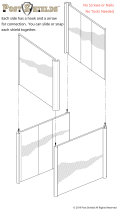
TABLE OF CONTENTS
0463 605 001 © ESAB AB 2019
1
SAFETY
.......................................................................................................
5
1.1 Meaning of symbols
...............................................................................
5
1.2 Safety precautions
.................................................................................
5
2
INTRODUCTION
..........................................................................................
8
2.1 Overview
.................................................................................................
8
2.2 Equipment
...............................................................................................
8
3
TECHNICAL DATA
......................................................................................
9
4
INSTALLATION
............................................................................................
11
4.1 Location
...................................................................................................
11
4.2 Lifting instructions
.................................................................................
11
4.3 Mains supply
...........................................................................................
12
5
OPERATION
................................................................................................
14
5.1 User connections and controls
.............................................................
15
5.2 Connection of welding and return cables
............................................
16
5.2.1 For MIG/MMA process ........................................................................ 16
5.2.2 For TIG process.................................................................................... 17
5.3 Polarity change
.......................................................................................
17
5.4 Shielding gas
..........................................................................................
17
5.5 Volt-ampere curves
................................................................................
17
5.5.1 SMAW (Stick) 400 V............................................................................. 18
5.5.2 GMAW (MIG) 400 V ............................................................................. 18
5.5.3 GTAW (TIG) 400 V ............................................................................... 19
5.6 Duty cycle
...............................................................................................
19
5.7 Removing/installing bobbin
..................................................................
20
5.8 Removing/installing wire
.......................................................................
21
5.8.1 Removing wire...................................................................................... 23
5.8.2 Installing wire........................................................................................ 25
5.9 Welding with aluminum wire
.................................................................
25
5.10 Setting wire-feed pressure
....................................................................
26
5.11 Removing/installing wire-feed rollers
..................................................
27
5.11.1 Removing wire-feed rollers................................................................... 27
5.11.2 Installing wire-feed rollers..................................................................... 29
5.12 Removing/installing/adjusting wire-guides
.........................................
30
5.12.1 Output wire-guide removal/installation ................................................. 32
5.12.2 Center wire-guide removal/installation ................................................. 33
5.12.3 Adjusting wire guides ........................................................................... 33
5.13 Overheating protection
..........................................................................
34
5.14 Lift-TIG welding
......................................................................................
34
6
CONTROL PANEL
.......................................................................................
36
6.1 How to navigate
......................................................................................
36
6.2 Main menu
...............................................................................................
36





















